An emergency fund is a savings fund specifically for unforeseen situations, such as a huge medical bill or unemployment. Many experts advocate for an emergency fund that could cover at least three to six months of your living expenses. However, there are still many people out there who do not think about the problems that can occur in the future that might require them to spend money.
For instance, what if someone loses their job one month and in the same month they fall sick? To top it all, the person might suddenly find that the foundation of their house is a bit too shaky (which might require attention from one of the most reputed house foundation repair companies near them). How will that person pay for all these if he has no emergency fund? Of course, he would not be able to!
So, hopefully, my readers have understood the importance of having some money as a backup. I really hope they have because I understood this the hard way (and I do not want them to suffer like me)!
Honestly, I have often found myself unable or struggling to meet my financial obligations for various reasons, and have learned the importance of saving for a rainy day. Getting there can however be challenging. Some manage this by taking out secured loans, but others are not in a position to take this initial boost to their income. I also found it difficult to set how much money I should put in or take out at any one point and what counts as an ’emergency’. Here are a few steps that have helped me over the years to build my emergency fund and some suggestions that could help you as well.
The ‘Pay Yourself First’ Rule
When I receive my paycheck, the first thing I do is to set aside the money for my savings, and then I budget the rest for spending. Since I find that I can have several things at a time that I am saving for, I prioritize my emergency fund and put it immediately in my savings account to resist the temptation of dipping into it for something else. Following this rule without compromising has helped me build my rainy day account over the years and every time I see the balance, I feel very proud of myself. I took the step further by automating this deduction where a certain percentage is automatically deducted from my income and directed to my savings account before I access my paycheck.
The ‘Keep the Change’ Rule
Another rule I set for myself geared towards building my emergency fund is keeping the change from every purchase and directing it to my savings account. A simple jar at home where I drop in $1 and $5 bills goes a long way. I completely removed the attitude that it’s too little because I found that the numbers do add up after some time.
Always Asses and Re-adjust
Another tip that I have found useful in building my emergency fund is to regularly check my balance and readjust whenever necessary. This is because emergencies do come up. You never know when a pipe might burst or a basement might flood. Most probably, you may have to call in some emergency plumbing services to fix the mess, but how will you do that without sufficient funds? The answer is an emergency fund. Since the goal is to maintain at least three to six months of living expenses, whenever I dip into my emergency fund I know I have to recover that money somehow. Also, in case I find that I have reached my desired amount, I either put in the extra money or invest it in something else. The goal is to save and not spend.
Make Sure the Money Grows
Another important thing I have found to be helpful in building my emergency fund is putting it in a high-yield savings account. A high-yield savings account is one where the interest rate is relatively high. This allows the saved money to grow while sitting in the account. There are multiple financial institutions that offer competitive interest rates for savings accounts while still maintaining easy access in case that emergency comes up. Every penny counts!
Additionally, you can also start investing in long-term assets similar to insurance. However, not many really consider insurance policies to be investment assets for the future. Unfortunately, such people might not be aware of the fact that health, life, or trauma insurance can help them bear the medical expenses in the future. Wondering how? Take, for example, the case of trauma insurance policies, which can be claimed (with the help of Curo Financial) if an individual suffers from Cancer, Heart Disease, and Stroke and seeks treatment for the same. Additionally, such policies can provide a benefit in the event that an individual is permanently incapacitated. Hopefully, readers might have understood why having one insurance policy, at the least, could prevent individuals from becoming financially unstable during cases of emergency.
Anyway, besides insurance, there are other investment options as well, like real estate, precious metals, bonds, and IRA, which can come in handy for emergency purposes as well as for retirement. These investment options can have low risks and can show a great improvement in value over a longer duration, which works great for people who want to plan for financial stability and retirement. Moreover, with the investment opportunities like IRA, you may also get an option to roll over the asset in gold IRA and physical gold, both having a positive value growth. If interested, you can check out articles such as – ‘gold ira vs physical gold which is the better investment for you?’ to get an idea of where to invest.
By following these simple steps, my emergency fund has significantly grown. The best part of it all is the security and peace of mind that comes with knowing that I have a buffer in case my house floods or me or an of my loved ones gets suddenly ill and would have to supplement any health insurance for medical bills. Maintaining the attitude that no money is little money has also helped me improve on how I handle any extra cash that comes my way. So we should not forget to keep those smaller bills and take our time to look at the interest rates that our accounts provider has to offer.




